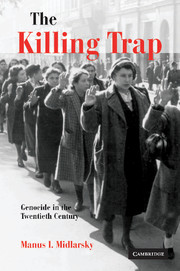Book contents
- Frontmatter
- Contents
- Preface
- PART I Introduction
- PART II Explaining perpetrators: theoretical foundations
- PART III The theory applied
- PART IV Victim vulnerability: explaining magnitude and manner of dying
- PART V Exceptions
- 15 A dog of a different nature: the Cambodian politicide
- 16 Dogs that didn't bark I: realpolitik and the absence of loss
- 17 Dogs that didn't bark II: affinity and vulnerability reduction
- PART VI Conclusion
- References
- Index
17 - Dogs that didn't bark II: affinity and vulnerability reduction
Published online by Cambridge University Press: 22 September 2009
- Frontmatter
- Contents
- Preface
- PART I Introduction
- PART II Explaining perpetrators: theoretical foundations
- PART III The theory applied
- PART IV Victim vulnerability: explaining magnitude and manner of dying
- PART V Exceptions
- 15 A dog of a different nature: the Cambodian politicide
- 16 Dogs that didn't bark I: realpolitik and the absence of loss
- 17 Dogs that didn't bark II: affinity and vulnerability reduction
- PART VI Conclusion
- References
- Index
Summary
Now we examine potential victimizers, apart from the Axis collaborating countries of World War II. There are seemingly innumerable available instances, but several strong possibilities present themselves based on variables already introduced in chapter 5. These are countries: (1) situated within the domain of losses, (2) experiencing threats to state security, (3) undergoing substantial risks, and (4) potentially targeting victims that have large affine populations or governments (ethnoreligiously similar or ideologically sympathetic, frequently in neighboring countries) with substantial political and/or military influence – the affinity condition.
This last variable is suggested to distinguish between potential genocides that eventuated in that outcome and those that did not, largely because of the prudent recognition by the potential victimizer of the importance of affinity. The targeted victim should not be in a position to react effectively or be able to call upon effective help from like-minded or ethnoreligiously similar populations. The existence of such potential allies, if deemed to be sufficiently powerful or at least influential in the international arena, could deter genocidal activity by a potential victimizer. Essentially, victim vulnerability, a necessary condition for genocide, can been reduced by the affinity condition.
However strong the genocidal impulse in a potential victimizer, a prudent realpolitik demands avoidance of the extreme risk of offending a large affine population or powerful government that can come to the aid of the victim. Of course, the fog of war increases the likelihood of an imprudent realpolitik that can be genocidal.
- Type
- Chapter
- Information
- The Killing TrapGenocide in the Twentieth Century, pp. 335 - 366Publisher: Cambridge University PressPrint publication year: 2005



